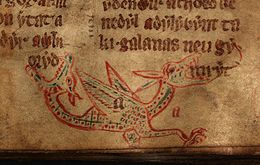|
Wyvern  The wyvern (/ˈwaɪvərn/ WY-vərn, sometimes spelled wivern) is a type of mythical dragon with two legs, two wings, and often a pointed tail.[4] The wyvern in its various forms is important in heraldry, frequently appearing as a mascot of schools and athletic teams (chiefly in the United States, United Kingdom, and Canada). It is a popular creature in European literature, mythology, and folklore. Today, it is often used in fantasy literature and video games. The wyvern in heraldry and folklore is rarely fire-breathing, unlike other dragons. EtymologyAccording to the Oxford English Dictionary, the word is a development of Middle English wyver (attested fourteenth century), from Anglo-French wivre (cf. French guivre and vouivre), which originate from Latin vīpera, meaning "viper", "adder", or "asp".[5][6] The concluding "–n" had been added by the beginning of the 17th century, when John Guillim in 1610 describes the "wiverne" as a creature that "partake[s] of a Fowle in the Wings and Legs ... and doth resemble a Serpent in the Taile".[5] John Gibbon in 1682 emphasises that it "hath but two Legs".[5] Conversely, medievalist William Sayers proposes a more complex origin for the term. He notes that the Anglo-French guivre and its Middle English derivative ceased to retain the original sense of "venomous snake" after the Latin term was re-introduced into medieval Latin, freeing them up to take an alternative meaning.[7]: 460 Adducing another meaning of wiver (this time Old English) and guivre, "light javelin",[7]: 461 and noting partial resemblances between the size and shape of javelins and snakes,[7]: 462 plus the later medieval era's increasing use of heavy armor and decreasing use of light javelins, he proposes that the concepts of "venomous snake" and "light javelin" were melded to produce a new term for a previously unimagined concept of flying snake, a kind of dragon.[7]: 463 History  The concept of winged snakes, mythical creatures similar to wyverns, is common in cultures around the Mediterranean, with a notable example being the Egyptian goddess Wadjet.[8] The oldest creatures outright referred to as "winged dragons" are Helios's chariot steeds, which aid Medea. In British heraldry, the term "wyver" first appears in Great Roll in 1312, and is derived from the Old French "wyvre", meaning "serpent". The term "dragon" appears by the following century. Afterwards, four-legged dragons become increasingly popular in heraldry and become distinguished from the two-legged kind during the sixteenth century, at which point the latter kind becomes commonly known as the "wyver" and later "wyvern".[9] Distinction from other dragonsSince the sixteenth century, in English, Welsh, Scottish, French and Irish heraldry, heraldic wyverns are defined as distinct entities from heraldic dragons. The key difference has been that a wyvern has two legs, whereas a dragon has four. This distinction is not commonly observed in the heraldry of other European countries, where two-legged dragon creatures are simply called dragons.[10][11] In modern fictionThe wyvern frequently features in modern fantasy fiction, such as Fourth Wing, though its first literary appearances may have been in medieval bestiaries.[12] In heraldry The wyvern is a frequent charge in English heraldry and vexillology, also occasionally appearing as a supporter or crest. A wyvern is typically depicted resting upon its legs and tail, but may be depicted with its claws in the air and only supported by its tail. On occasion, a wyvern may be depicted as wingless and with its tail nowed.[11] A silver (argent) wyvern formed the crest of the Borough of Leicester as recorded at the heraldic visitation of Leicestershire in 1619: "A wyvern sans legs argent strewed with wounds gules, wings expanded ermine." The term "sans legs" may not imply that the wyvern was "without legs", rather than its legs are not depicted, being hidden or folded under.[13][14][15] This was adopted by the Midland Railway in 1845 when it became the crest of its unofficial coat of arms.[16] The company asserted that the "wyvern was the standard of the Kingdom of Mercia", and that it was "a quartering in the town arms of Leicester".[17][18][19] However, in 1897 the Railway Magazine noted that there appeared "to be no foundation that the wyvern was associated with the Kingdom of Mercia".[20] It has been associated with Leicester since the time of Thomas, 2nd Earl of Lancaster and Leicester (c. 1278–1322), the most powerful lord in the Midlands, who used it as his personal crest.[21] A green Wyvern stands in the emblem of the ancient and historical Umbrian city of Terni, the dragon is called by the citizens with the name of Thyrus. A sable wyvern on a white background with endorsed wings forms the coat of arms of the Tilley family. The arms of the Worshipful Society of Apothecaries depict a wyvern, symbolising disease, being overcome by Apollo, symbolising medicine. Wyvern Zilant is depicted on the coat of arms of the city of Kazan, the capital of the Republic of Tatarstan. As a logo or mascotThe wyvern is a popular commercial logo or mascot, especially in Wales and what was once the West Country Kingdom of Wessex, but also in Herefordshire and Worcestershire, as the rivers Wye and Severn run through Hereford and Worcester respectively. A local radio station was formerly called Wyvern FM. Vauxhall Motors had a model in its range in the 1950s called the Wyvern. The Westland Wyvern was a British single-seat carrier-based multi-role strike aircraft built by Westland Aircraft that served in the 1950s, seeing active service in the 1956 Suez Crisis.
Examples
See alsoWikimedia Commons has media related to Wyverns. References
External linksWikimedia Commons has media related to Wyverns. |









![General Nursing Badge awarded to graduates of the Epworth Hospital General Nursing School (1924–1988). This particular design features a wyvern and the motto Non ministrari sed ministrare (not to be served but to serve). The design was adopted for use by nursing training schools established by the Methodist Church in Adelaide (Memorial Hospital) and Sydney (Waverly War Memorial Hospital).[23][24]](http://upload.wikimedia.org/wikipedia/commons/thumb/b/bc/Epworth_Hospital_General_Nursing_Badge_circa_1987.jpg/250px-Epworth_Hospital_General_Nursing_Badge_circa_1987.jpg)

